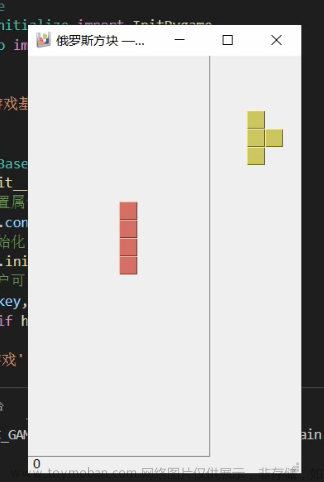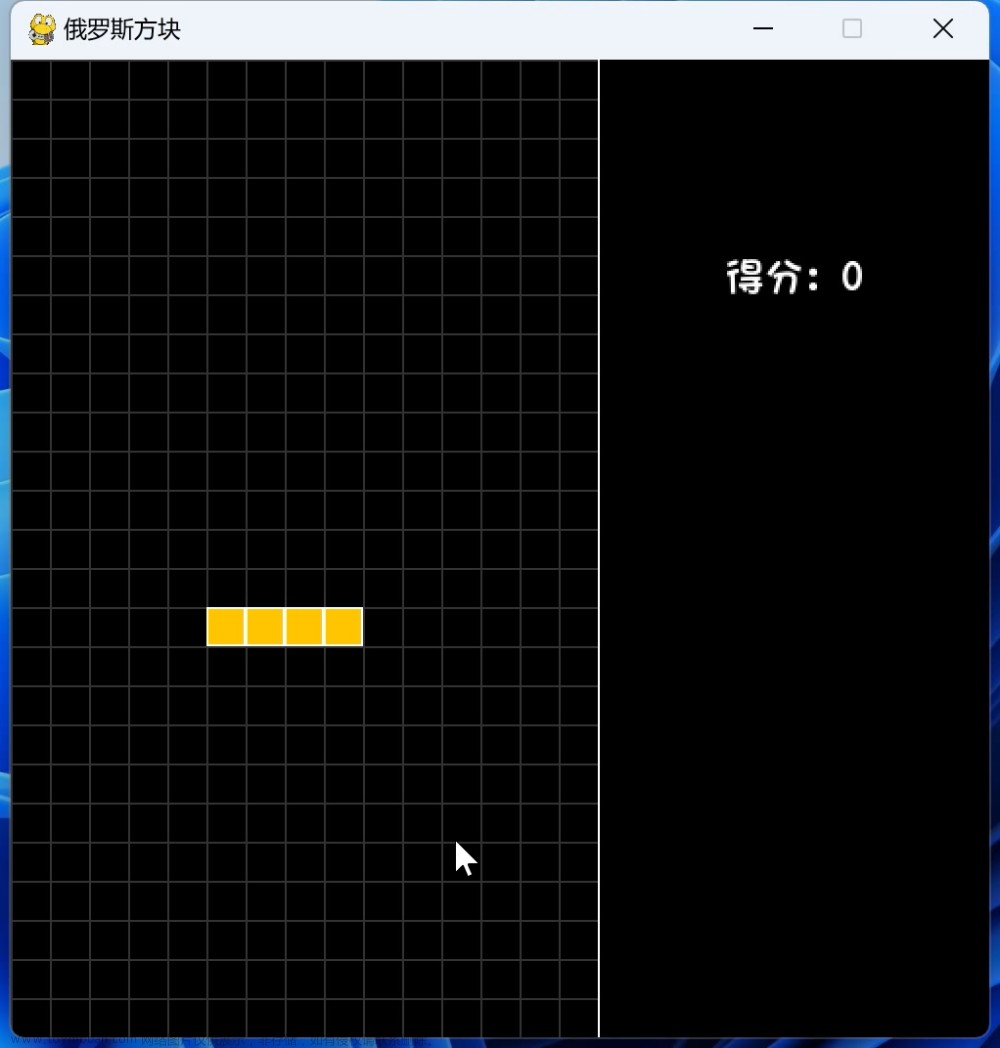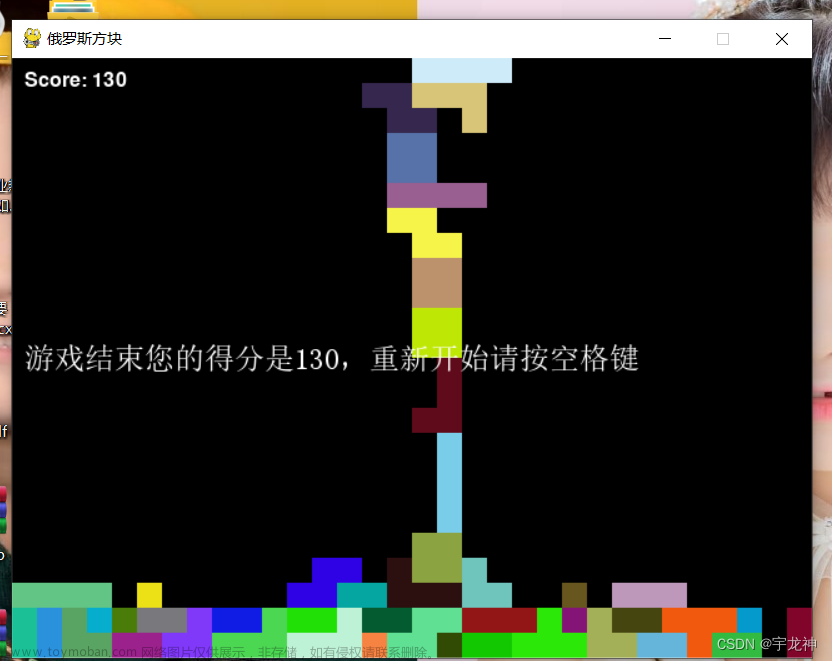大家好,我是辣条!
今天带大家来写一个说难不难,说简单也不算接单的复古小游戏:俄罗斯方块游戏!
前言:
俄罗斯方块是一款经典的益智游戏,通过移动、旋转和放置不同形状的方块,你需要尽可能地填满一行或多行来消除方块。现在,让我们一起用Python来编写一个完整的俄罗斯方块游戏吧! |

步骤
首先
- 我们需要导入必要的模块。我们将使用pygame模块来创建游戏窗口和处理用户输入, 以及random模块来随机生成方块的形状。
-
接下来
- 我们需要定义一些常量,如游戏窗口的宽度和高度,方块的大小等。我们还需要定义一些变量,如当前方块的位置和形状,游戏区域的状态等。
-
然后
- 我们需要编写一些函数来处理游戏的逻辑。例如,我们需要一个函数来生成新的方块,一个函数来移动方块,一个函数来旋转方块,以及一个函数来判断是否可以放置方块等。
-
接下来
- 我们需要编写一个主循环来处理游戏的运行。在每一帧中,我们需要更新方块的位置,处理用户输入,判断是否有行可以消除,以及绘制游戏界面等。
-
最后
- 我们需要添加一些游戏结束的条件,例如当方块无法再放置时,游戏结束。在游戏结束时,我们可以显示玩家的得分,并询问是否重新开始游戏。
-
现在,让我们开始编写这个俄罗斯方块游戏吧!在下面的代码编辑器中,你可以找到一个基本的游戏框架,你可以根据需要进行修改和完善。祝你编写愉快,玩得开心!文章来源:https://www.toymoban.com/news/detail-651431.html
上代码:
import pygame import random # 初始化游戏 pygame.init() # 设置游戏窗口的宽度和高度 width, height = 800, 600 screen = pygame.display.set_mode((width, height)) # 定义方块的大小 block_size = 30 # 定义游戏区域的宽度和高度 play_width, play_height = 10 * block_size, 20 * block_size # 定义游戏区域的起始位置 play_x, play_y = (width - play_width) // 2, height - play_height - 50 # 定义颜色 black = (0, 0, 0) white = (255, 255, 255) blue = (0, 0, 255) red = (255, 0, 0) green = (0, 255, 0) yellow = (255, 255, 0) purple = (128, 0, 128) orange = (255, 165, 0) cyan = (0, 255, 255) # 定义方块的形状 S = [['.....', '.....', '..00.', '.00..', '.....'], ['.....', '..0..', '..00.', '...0.', '.....']] Z = [['.....', '.....', '.00..', '..00.', '.....'], ['.....', '..0..', '.00..', '.0...', '.....']] I = [['.....', '..0..', '..0..', '..0..', '..0..'], ['.....', '0000.', '.....', '.....', '.....']] O = [['.....', '.....', '.00..', '.00..', '.....']] J = [['.....', '.0...', '.000.', '.....', '.....'], ['.....', '..00.', '..0..', '..0..', '.....'], ['.....', '.....', '.000.', '...0.', '.....'], ['.....', '..0..', '..0..', '.00..', '.....']] L = [['.....', '...0.', '.000.', '.....', '.....'], ['.....', '..0..', '..0..', '..00.', '.....'], ['.....', '.....', '.000.', '.0...', '.....'], ['.....', '.00..', '..0..', '..0..', '.....']] T = [['.....', '..0..', '.000.', '.....', '.....'], ['.....', '..0..', '..00.', '..0..', '.....'], ['.....', '.....', '.000.', '..0..', '.....'], ['.....', '..0..', '.00..', '..0..', '.....']] # 定义方块的颜色 shapes = [S, Z, I, O, J, L, T] shape_colors = [green, red, cyan, yellow, blue, orange, purple] # 定义方块类 class Piece(object): rows = 20 columns = 10 def __init__(self, column, row, shape): self.x = column self.y = row self.shape = shape self.color = shape_colors[shapes.index(shape)] self.rotation = 0 # 定义游戏区域 def create_grid(locked_positions={}): grid = [[black for _ in range(Piece.columns)] for _ in range(Piece.rows)] for row in range(Piece.rows): for col in range(Piece.columns): if (col, row) in locked_positions: color = locked_positions[(col, row)] grid[row][col] = color return grid # 检查方块是否在游戏区域内 def valid_space(piece, grid): for row in range(len(piece.shape)): for col in range(len(piece.shape[row])): if piece.shape[row][col] == '0': if piece.y + row >= Piece.rows or piece.x + col < 0 or piece.x + col >= Piece.columns or \ grid[piece.y + row][piece.x + col] != black: return False return True # 检查是否有行可以消除 def check_clear_rows(grid, locked_positions): full_rows = [] for row in range(Piece.rows): if black not in grid[row]: full_rows.append(row) for row in full_rows: for col in range(Piece.columns): del locked_positions[(col, row)] if len(full_rows) > 0: for key in sorted(list(locked_positions), key=lambda x: x[1])[::-1]: col, row = key if row < max(full_rows): new_key = (col, row + len(full_rows)) locked_positions[new_key] = locked_positions.pop(key) return len(full_rows) # 绘制游戏区域 def draw_grid(surface, grid): for row in range(Piece.rows): for col in range(Piece.columns): pygame.draw.rect(surface, grid[row][col], (play_x + col * block_size, play_y + row * block_size, block_size, block_size)) pygame.draw.rect(surface, white, (play_x + col * block_size, play_y + row * block_size, block_size, block_size), 1) # 绘制方块 def draw_piece(surface, piece): for row in range(len(piece.shape)): for col in range(len(piece.shape[row])): if piece.shape[row][col] == '0': pygame.draw.rect(surface, piece.color, (play_x + (piece.x + col) * block_size, play_y + (piece.y + row) * block_size, block_size, block_size)) pygame.draw.rect(surface, white, (play_x + (piece.x + col) * block_size, play_y + (piece.y + row) * block_size, block_size, block_size), 1) # 绘制游戏界面 def draw_window(surface, grid, score=0): surface.fill(black) pygame.font.init() font = pygame.font.SysFont('comicsans', 60) label = font.render('Tetris', 1, white) surface.blit(label, (play_x + play_width / 2 - (label.get_width() / 2), 30)) font = pygame.font.SysFont('comicsans', 30) label = font.render('Score: ' + str(score), 1, white) surface.blit(label, (play_x + play_width + 50, play_y + play_height / 2 - label.get_height() / 2)) draw_grid(surface, grid) # 主函数 def main(): locked_positions = {} grid = create_grid(locked_positions) change_piece = False run = True current_piece = Piece(5, 0, random.choice(shapes)) clock = pygame.time.Clock() fall_time = 0 fall_speed = 0.27 level_time = 0 score = 0 while run: grid = create_grid(locked_positions) fall_time += clock.get_rawtime() level_time += clock.get_rawtime() clock.tick() if level_time / 1000 > 5: level_time = 0 if fall_speed > 0.12: fall_speed -= 0.005 if fall_time / 1000 >= fall_speed: fall_time = 0 current_piece.y += 1 if not valid_space(current_piece, grid) and current_piece.y > 0: current_piece.y -= 1 change_piece = True for event in pygame.event.get(): if event.type == pygame.QUIT: run = False pygame.display.quit() quit() if event.type == pygame.KEYDOWN: if event.key == pygame.K_LEFT: current_piece.x -= 1 if not valid_space(current_piece, grid): current_piece.x += 1 if event.key == pygame.K_RIGHT: current_piece.x += 1 if not valid_space(current_piece, grid): current_piece.x -= 1 if event.key == pygame.K_DOWN: current_piece.y += 1 if not valid_space(current_piece, grid): current_piece.y -= 1 if event.key == pygame.K_UP: current_piece.rotation = (current_piece.rotation + 1) % len(current_piece.shape) if not valid_space(current_piece, grid): current_piece.rotation = (current_piece.rotation - 1) % len(current_piece.shape) shape_pos = [(col + current_piece.x, row + current_piece.y) for row in range(len(current_piece.shape)) for col in range(len(current_piece.shape[row])) if current_piece.shape[row][col] == '0'] for pos in shape_pos: if pos[1] >= 0: grid[pos[1]][pos[0]] = current_piece.color if change_piece: for pos in shape_pos: locked_positions[(pos[0], pos[1])] = current_piece.color current_piece = Piece(5, 0, random.choice(shapes)) change_piece = False score += check_clear_rows(grid, locked_positions) draw_window(screen, grid, score) draw_piece(screen, current_piece) pygame.display.update() if any(pos[1] <= 0 for pos in shape_pos): run = False pygame.display.quit() # 运行游戏 if __name__ == '__main__': main()总结:
这个示例代码使用了Pygame库来实现游戏窗口和图形的绘制。游戏区域使用一个二维数组来表示,每个方块的位置和颜色都存储在这个数组中。游戏的主循环中,不断更新方块的位置和状态,并检查是否有行可以消除。游戏界面使用黑色背景,方块使用不同的颜色来表示。你可以根据自己的需求对代码进行修改和扩展。
俄罗斯方块以其独特的风格和玩法,成为了当今游戏界的一股清流。它们不仅让玩家重温过去的游戏经典,更能够带来一种怀旧的情感。无论是喜欢挑战的玩家,还是追求简单乐趣的玩家,复古游戏都能够满足他们的需求。让我们一起回味那些曾经的游戏时光,感受复古游戏的魅力吧!文章来源地址https://www.toymoban.com/news/detail-651431.html
到了这里,关于用Python打造复古风格的游戏:回归8位时代【俄罗斯方块】的文章就介绍完了。如果您还想了解更多内容,请在右上角搜索TOY模板网以前的文章或继续浏览下面的相关文章,希望大家以后多多支持TOY模板网!













